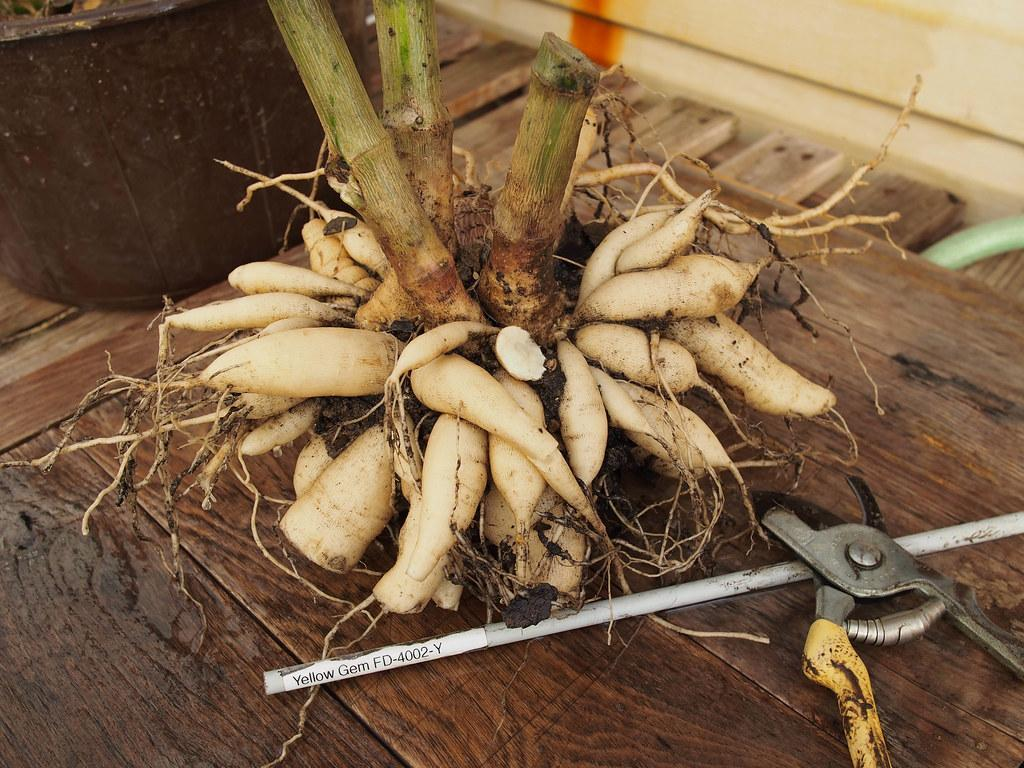
Fasciculated roots for food storage and vegetative propagation are found in
(a) Ipomoea batatas
(b) Raphanus sativus
(c) Grasses
(d) Dahlia
Answer
583.2k+ views
Hint: Fasciculated roots are found in the monocots. They can be directly sown into the soil with proper sunlight and water to produce new plantlets.
Fasciculated roots are present in Dahlia that act as an organ of food storage and vegetative propagation.
Fasciculated roots are the modification of adventitious roots. They arise from the base of the stem and become clustered. They swell and thick in order to store food and can be eaten as vegetables. It is seen as the dahlia, asparagus.
Additional Information:
Adventitious roots are the type of roots that arise from any part of the plant other than the radicle. They can be modified into a number of structures (for the storage of food) other than the fasciculated roots: 1. Tuberous root- Here, the root becomes swollen to store food, for example, potatoes.
2. Moniliform root- Here, the roots are swollen at regular intervals so as to give them a beaded appearance. It is seen in Rose moss.
3.Annulated root- Here, the root grows into a long annulated structure formed by stacks of the ring-like outgrowth. It is seen in Ipecac.
4.Nodulated root- Here, the root becomes swollen at tips. It is seen in turmeric.
So, the correct answer is Dahlia.
Note:
1. The fasciculated root of dahlia act as a vegetative propagule for the production of a new dahlia plant. It results in the production of clones or exact copies of the parent plant. It results in the accumulation of harmful or less desirable characters in the progeny.
2. The Dahlia plant can also be produced from stem cuttings and seeds.

Fasciculated roots are present in Dahlia that act as an organ of food storage and vegetative propagation.
Fasciculated roots are the modification of adventitious roots. They arise from the base of the stem and become clustered. They swell and thick in order to store food and can be eaten as vegetables. It is seen as the dahlia, asparagus.
Additional Information:
Adventitious roots are the type of roots that arise from any part of the plant other than the radicle. They can be modified into a number of structures (for the storage of food) other than the fasciculated roots: 1. Tuberous root- Here, the root becomes swollen to store food, for example, potatoes.
2. Moniliform root- Here, the roots are swollen at regular intervals so as to give them a beaded appearance. It is seen in Rose moss.
3.Annulated root- Here, the root grows into a long annulated structure formed by stacks of the ring-like outgrowth. It is seen in Ipecac.
4.Nodulated root- Here, the root becomes swollen at tips. It is seen in turmeric.
So, the correct answer is Dahlia.
Note:
1. The fasciculated root of dahlia act as a vegetative propagule for the production of a new dahlia plant. It results in the production of clones or exact copies of the parent plant. It results in the accumulation of harmful or less desirable characters in the progeny.
2. The Dahlia plant can also be produced from stem cuttings and seeds.

Recently Updated Pages
Master Class 12 Business Studies: Engaging Questions & Answers for Success

Master Class 12 Economics: Engaging Questions & Answers for Success

Master Class 12 English: Engaging Questions & Answers for Success

Master Class 12 Maths: Engaging Questions & Answers for Success

Master Class 12 Social Science: Engaging Questions & Answers for Success

Master Class 12 Chemistry: Engaging Questions & Answers for Success

Trending doubts
What is meant by exothermic and endothermic reactions class 11 chemistry CBSE

Which animal has three hearts class 11 biology CBSE

10 examples of friction in our daily life

One Metric ton is equal to kg A 10000 B 1000 C 100 class 11 physics CBSE

1 Quintal is equal to a 110 kg b 10 kg c 100kg d 1000 class 11 physics CBSE

Difference Between Prokaryotic Cells and Eukaryotic Cells




